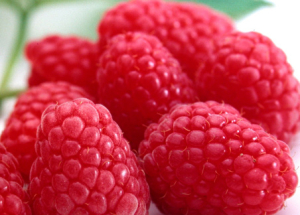Surely no one garden orchard can do without raspberries. This perennial shrub is capable of yielding a great harvest. Some varieties are harvested twice per season. And the useful properties of a wonderful plant are known throughout the world. Just think, from raspberries you can cook jam, compotes, pastries, get treatment for colds. For this, the plant needs the right care: treatment, disposal of pests, fertilizing.
Content
Raspberry how to care
Caring for raspberries is necessary both during the season and after it. Pay special attention during preparation for the summer. It is from this will depend on the yield of raspberries.
care for raspberries in spring
Immediately after the snow came down and the soil was a bit dry, the summer residents hurry to their sites for revision. The raspberries, which have departed from winter, are usually prepared for harvest season. The main preparation of raspberries for harvest is in the spring. Its branches untie, after being laid for the winter from the cold. Then straighten out and check the presence of frosted branches. In case of detection of such, remove them with garden scissors to a living place on the shoot.
When a live branch is detected, but frozen chicks, this element is not removed. Time will pass and from the axillary and sleeping buds will appear green leaves. But the broken and damaged branches must be pruned with a pruner.
Toward the end of May, remove thin shoots. So, the new bush will have more moisture and incoming nutrients. After the growth of the kidneys, to see places for circumcision, trim the branches of raspberries to a distance of 120-150 cm. Later on, these raspberries will have a larger fruit. At the end of the "renovation" of the shoots tie them to the wire trellis. Tie the branches in such a way as not to constrain the plant.
Care for raspberry top dressing in the spring
- If you notice that the raspberry bushes are badly overgrown with new shoots, then you can revive the bush by applying manure. Add a shovel of cow or chicken fertilizer mixed with a bucket of saltpeter or urea under the bush (1 matchbox is bred on a bucket of water). This is enough for the entire fruitful period.
- In the spring, mulch is placed around the rhizomes of crimson shrubs to retain moisture and mineral substances. Before this loosen the soil at a depth of about 10 cm. Mulch is a kind of waste from grain, rotted hay, peat, the contents of compost pits.
- Before flowering raspberries must be treated with insecticide. They will protect the plant from a raspberry beetle and a stalk flies that eat flowering shoots.
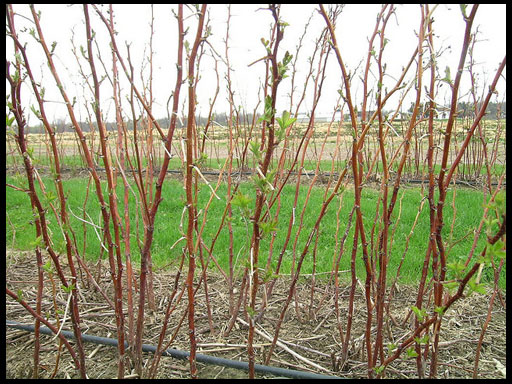
care for raspberries in summer
Summer care for raspberry bushes is carried out on mulched places. Weeding row rows to insignificant depth. Shoots that appeared in the summer are usually removed. Leave for breeding a few strong branches (do it better closer to the autumn).
You also need to care for raspberries after flowering. It is necessary to spray the branches and leaves of the plant against pests. When yellow and dry leaves appear, remove and burn.
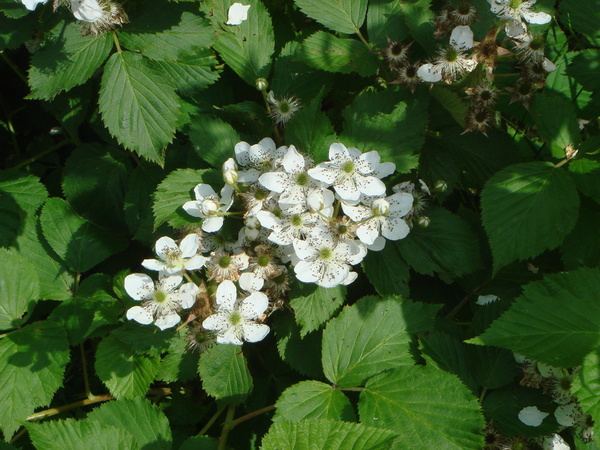
care for raspberries in autumn
Autumn care for raspberries is quite simple:
- Before winter, it is necessary to again spray the plants, so that there are no insects that will want to overwinter there;
- Secateurs remove weak shoots and those that bear fruit. They are cut to the very root. If you notice dry or broken branches, they must also be removed to a healthy living place;
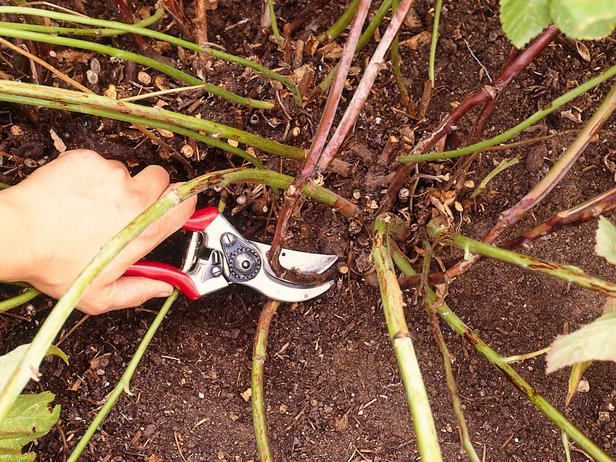
- Shoots that have grown a long distance, you need to dig up;
- Mulch is dug up. Under the roots are potassium fertilizers;
- After a couple of weeks, you can untie the shoots from the stakes (or tapestries) and tie their bundles. The bound raspberries should be laid as close as possible to the ground so that in winter it will be under a layer of snow and not frozen.
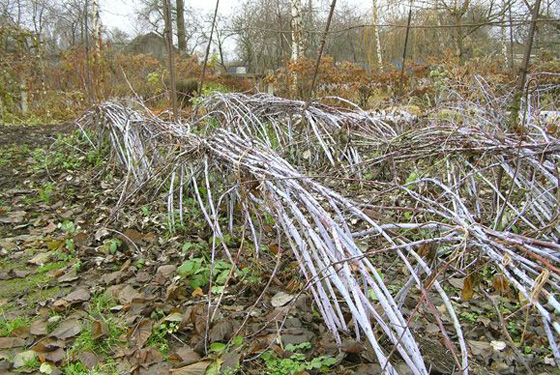
Raspberry raspberry disease
Raspberry diseases can adversely affect yields. And after the winter, the plant and at all can die. Therefore, in order to avoid such situations it is important to know what these or other diseases of raspberry bushes look like. Distinguish them in fungal and viral.
The most common fungal diseases of raspberries are:
- Anthracnose;
- Spotting;
- Rust;
- Gray berry rot.
Among the virus diseases are:
- Curly;
- Mosaic;
- Chlorosis;
- Growing.
anthracnose
Anthracnose is a disease that arises from the penetration of the fungus Gloeosporium venetum Speg into leaves, shoots and the root system. As is known, mushrooms love moisture. Therefore, almost all raspberries in the humid terrain suffer from this ailment.
You can detect this disease on the leaves or stems of raspberries. The tissues of the plant are covered with gray circles bordered by a brown ring. There may be both small points, and formations, reaching 3-5 mm. They can also unite, and then the sheet splits and a cleft is formed. Every new spot, this is a separate defeat.
On the berries this disease passes extremely rarely. Spots are not observed on them, but their development stops the fruit. For example, if the disease caught the berry in the period of pouring, then the fruit will remain ungathered. Moreover, it is mummified.
Anthracnose is tolerated by spores after rain or during dew. It can also be carried by insects. Most young branches and ends of the branches give way to defeat. If the affected areas are not treated in time, the plant will go on hibernation along with the disease. Mushrooms of Gloeosporium venetum Speg are frost-resistant. With the onset of spring, they will continue their reproduction and can destroy raspberries.
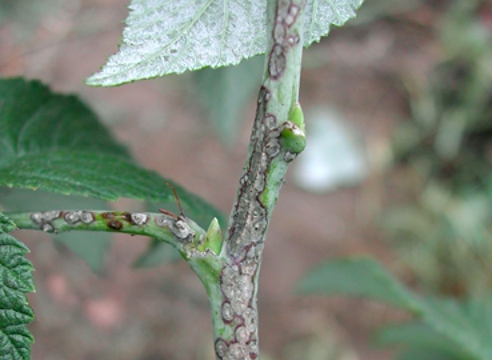
At present, anthracnose is well studied and is amenable to elimination. The first and most necessary measure in eliminating the disease is the removal of diseased leaves and shoots. They need not just be thrown out, but burned. Shrubs with running current are excavated and burned.
The remaining healthy branches must be treated with Bordeaux mixture (3%). Another effective tool is copper oxychloride (0.5%).
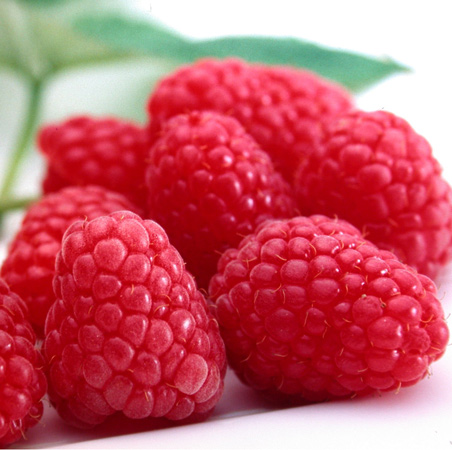
spotting
There are several varieties of spotting:
- White;
- Purple;
- In autumn.
White spotting is shown on the leaves of a raspberry. The edges of the ring are brown. Over time, the disease can spread to the stems. A white spot can have black spots in the middle - these are the spores of the pathogen.
Purple spotting - one of the most harmful varieties of spotting. It affects the kidneys, stems and leaves of raspberry. A sign of the disease are purple foci. They can blur and form in the middle of light spots with the presence of tubercles. Bumps are the spores of a fungus-pest. Fruiting shoots as a result of the disease may dry up if the appropriate measures are not taken.
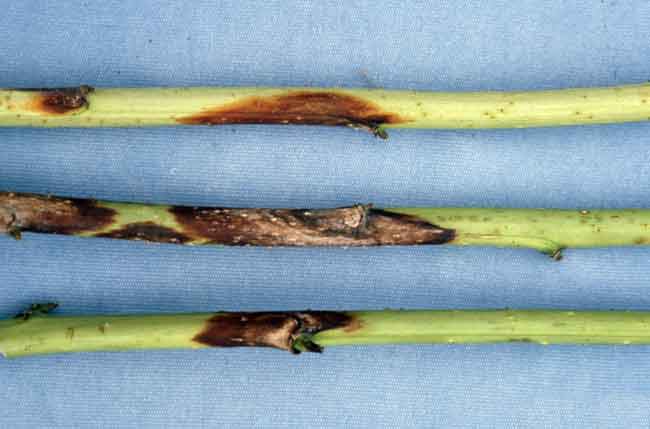
Autumn spotting - is expressed in the formation of spots of dark brown color on leaves of any age. The stems do not suffer. The soreness of the leaves appears closer to the autumn. By the end of August - beginning of September. The leaves begin to darken and fall off. This reduces the chances of laying healthy kidneys.
Spotting Treatment
Treatment begins with the elimination of diseased shoots and their complete burning, thinning bushes and timely removal of weeds. Of the drugs used fungicides and spend spraying from insects in three stages (before flowering, after harvest and before winter).
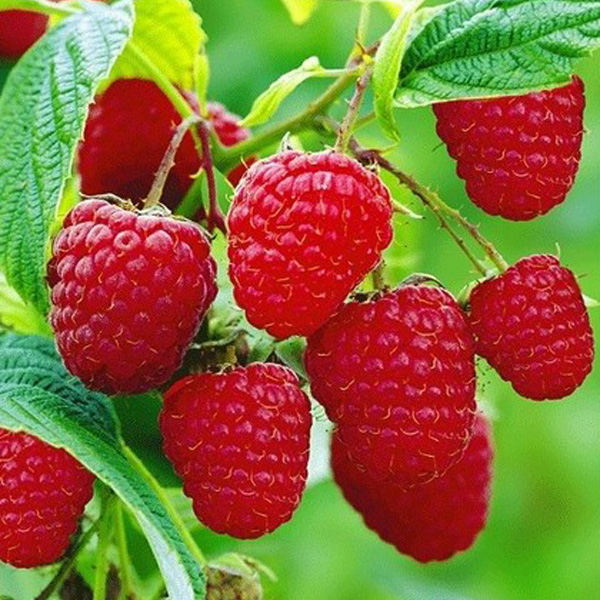
raspberry rust
Rust on the crimson bushes begins mainly in the summer. First, yellow or orange growths appear on the sheets. By autumn, the spots become dark. Difficulties of the disease are the delay in the development of shoots and the loss of leaves.
It is treated the same way as spotting. It is necessary to inspect the area of raspberry, burn the sick foliage and sprinkle with chemical fluid.
gray berry rot
It appears directly on the berries during the ripening period. Small spots increase as the fetus grows. Then they are covered with a fluffy hat due to fungus spores. So, the berry starts to rot.
It is necessary to get rid of such berries as soon as possible. Treatment of rot is the timely prevention of the spread of the disease. Once you notice such formations, remove them. If the rot spread throughout the bush, excavate it and burn it. Do not allow thickening of the territory, thin the raspberry and remove excess shoots.
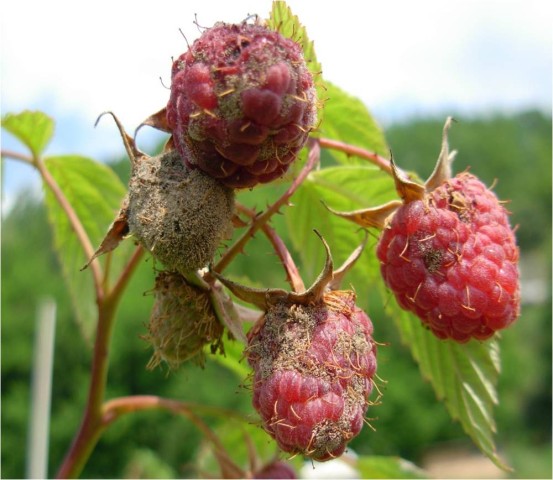
curly raspberry
Curly crimson bushes - this is a viral disease, which is noticeable not immediately. They appear with time. First, the veins die, the corners of the leaf become twisted, and by autumn shoots stop their growth and the leaves darken. After 2-3 years the plant can die, it will change a lot. At the site of shoot formation, nothing will grow. The shoots will become massive and hook-like. Fighting such a disease is not easy. Even if you remove the bush. At this point the newly planted plant will again become infected with this disease.
One type of aphid is transmitted. She is inactive, which gives a chance to eliminate the pest before it inflicts an unreasonable damage to the orchard.

raspberry mosaic
The mosaic is expressed on raspberry leaves. With the acquisition of the virus, they become variegated. Can be either large or small spots, light or more saturated. Because of the virus, raspberries do not develop well and yield decreases. As a result, after 7 years the bush dies.
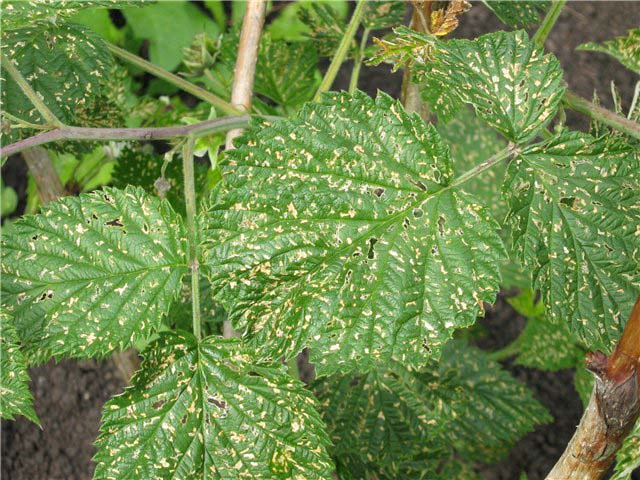
chlorosis
Chlorosis - is a rapidly spreading disease throughout the raspberry. Penetrates to the site with the acquired plant. It consists in the fact that the raspberry turns yellow in the leaves. The disease manifests itself immediately after they have opened out of the kidney. Because of the infectious infection, they stop their growth. Berries in turn do not differ in taste. Moreover, they become small and dry. As for shoots, they are very weak.
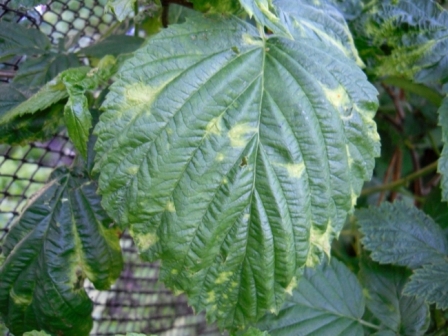
sprouting
Growth or Witch Broom is an aggressive viral disease that can spread to all raspberry bushes. It is taken from the planting material. Expressed in the abundant growth of new shoots. At the same time there is no fruit. It can last several years, but until the end the bush does not die. During this time it becomes just a dwarfish size. Sometimes reaches a mark of 12-15 cm.
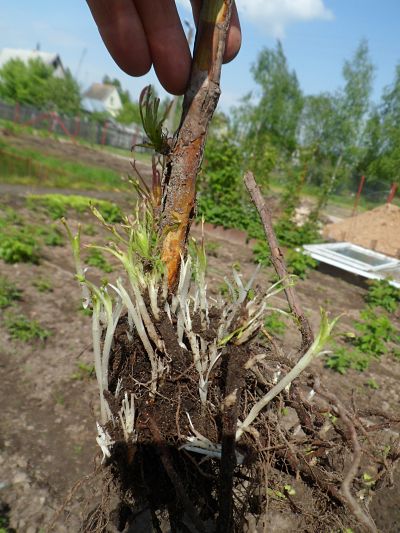
combating viral diseases of raspberries
- Timely application of fertilizers.
- Three-time spraying.
- Acquisition of healthy planting shrubs.
- Aeration and loosening of the soil.
- Timely elimination of insects. Even small groups.
- Transplant only healthy plants.
- Apply to planting resistant varieties of raspberries.

Pests of raspberry
The main pests of raspberries are:
- Stem fly;
- The raspberry beetle;
- Running raspberry gall midges;
- Malynnaya stem cauliflower;
- Raspberry buds;
- Raspberry mite;
- Spider mite;
- Aphid.
Stem fly - penetrates into the stem, larvae are deposited there. It is possible to notice a raspberry fly when the leaves and top begin to dry out. This is due to the fact that the flour sharpens the shoots, and its offspring eventually falls down and hibernates right in the stem. With the advent of spring, flies fly out. They sit down on the leaves and are taken for their destruction.
You can fight it by spraying before flowering, after it and before winter. When detecting dry tops, break them off. Perhaps you will find the most harmful larva there. Do such audits as often as possible.
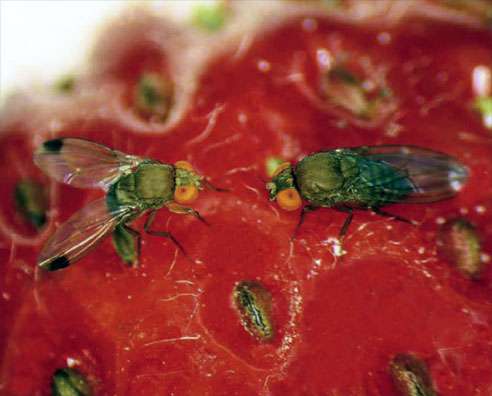
The raspberry beetle - Harmful, like the stem-fly together with its larvae. She settles in an unopened flower, lays eggs there. After 10 days, larvae appear. They feed on the same as the adult individual - flowering buds and plant stems. You can see such a pest on the gnawed pieces around the veins of the leaf, or inside the flower. His larvae are hiding in berries.
The fight against the raspberry beetle should be taken immediately. Collect the berries filled with grubs and burn them. In the morning walk around the site and collect pests by hand. Leave under the bush it is impossible, as they can spread to the healthy territory of the raspberry.
During autumn harvesting, carefully dig up bushes. Remove the weeds.
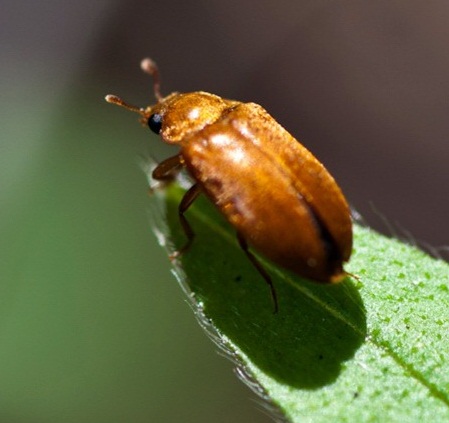
Raspberry gall midges - The pest for the summer makes several egg clutches. As a result, larvae are excavated under the bark. You can find them on the cracked bark of the bush. If you bend the dry part, you will see pests. They eat up the inside. As a result, the branches of raspberry dry up and break down. The plant becomes unsuitable for fruiting.
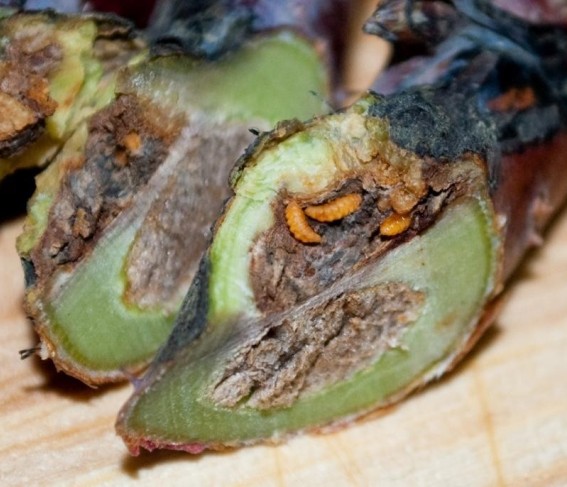
Raspberry gall in stalk - lays eggs directly on the bottom of young shoots. Larvae penetrate there. A few days later, a swollen area will form there. There and winter pests. If such areas are found, the damaged shoots should be removed immediately.
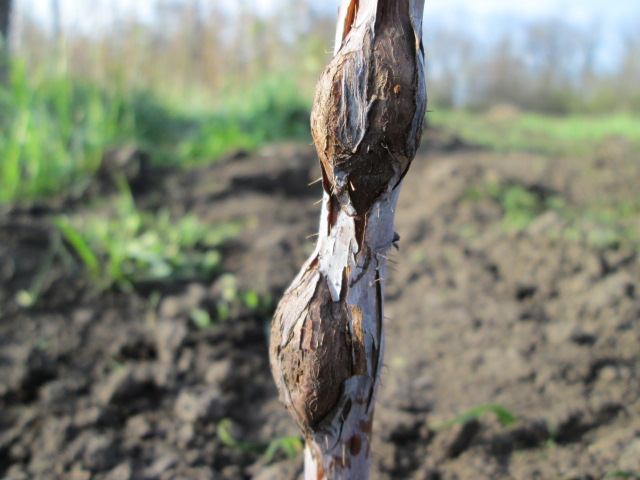
Raspberry bud mole - this pest is dangerous because it penetrates into the raspberry buds. While eating the contents, the mole goes into the depths of the shoot, moving lower and lower. As a result, the bush remains without harvest. Discovered pest in the spring in the stopped shoots.
Raspberry mite - This pest settles under the leaves of a raspberry. It can be noticed by the resulting oily stain on the outside of the sheet. For the winter they go under the buds. Even at a temperature of 11 degrees they lose their activity. Adult individuals winter under the scales of the kidneys and degrees of raspberry mites become inactive. With the advent of spring, they again wake up.
Spider mite - settles on weak plants. Mostly in dry weather. It lives like a raspberry mite on the underside of the leaves. Only he is noticeable in his web, entangling a leaf. It hibernates near raspberry bushes in weeds and foliage.
Aphid - a dangerous pest not only for raspberry. There are several varieties, but they are all equally dangerous for the garden plots. Aphids carry viral diseases. When such a pest is found, it is necessary to carry out the treatment of the plant as soon as possible.
Control measures against raspberry pests:
First of all, it is worthwhile to know that when planting a plot with raspberry culture, it is necessary to take healthy materials. Even better, if it's rhizomes. After harvesting, always remove the stems that have fruited. Carry out chemical treatment before hibernation.
When pests are detected between spraying, a solution of fufanone can be used. It is prepared as follows: a 10 ml syringe is diluted in 10 liters of water. Consumption for 10 bushes - 2 liters of diluted mixture. Still you can use pyrethroid "Intavir". One tablet is diluted in 10 liters of water. For 10 bushes, use 1.5 liters of diluted mixture.
In addition to chemical treatment, remove damaged and diseased shoots. In cases of dominance by pests, near the bush it is necessary to cut off the ground part. So, the plant will have a chance for healthy development and renewal of yield.
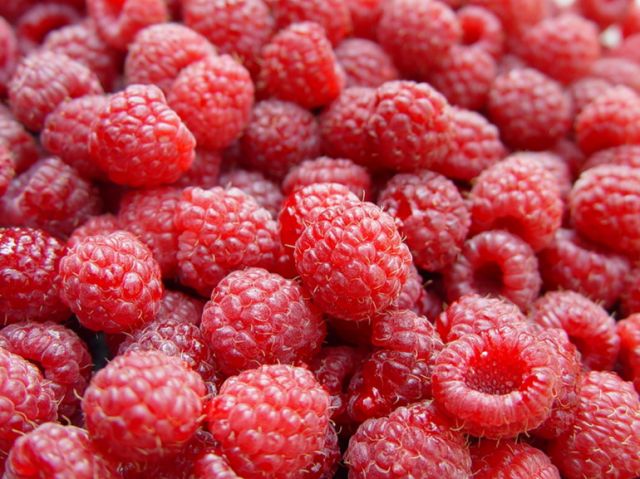
Raspberry varieties reviews
Specifically, the best varieties of raspberries can not be named. Since different people's taste perception is different. Moreover, each variety is unique in its own way. But it is possible to distinguish stable varieties with good yields.
Maria, the Leningrad Region.
"Yellow raspberry planted a raspberry. They waited for their first harvest. The variety is stable, I survived the winter. The yellow berries are sweet and large. "
Really raspberry variety Giant or, as its summer residents call it, the Yellow giant, is suitable for cultivation in the central strip of Russia. The average maturity and the resistance of the variety allow the bush to yield a stable yield. Fruits of the Yellow Giant can reach the width of the matchbox. A pleasant yellow shade of berries differs from the usual red.
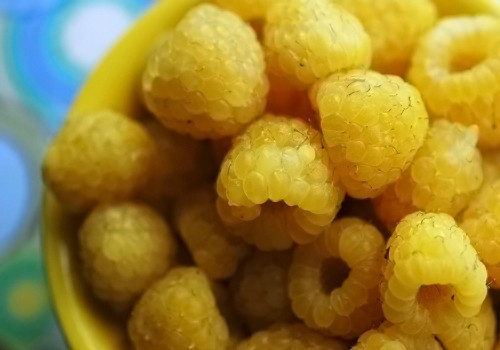
Irina, Kolomna, Moscow region
"Of the large varieties planted in the country dacha and polka. From the early ruby heracles, meteor. All berries are sweet. We do not have time to collect! "
Variety Hercules Suitable for a variable climate, it is resistant to many pests and diseases. Indiscriminate raspberry bushes bring a large crop. Each berry weighs about 10-12 g. The taste is sweet and juicy. The bush grows very powerful, and multiplies rapidly.
Malina Polka is a patchwork grade. Urozhozh for the season two times. The first collection in July and the next one will be stretched until November. The fruits of Polka are large - 10 g. Therefore, branches of the bush will be quite powerful. In general, the variety is non-selective and is like for variable climatic conditions.
From early varieties of raspberries, truck farmers distinguish:
- Bryansk Divo;
- The fugitive;
- Meteor;
- Early Dawn;
- Vega;
- Abundant;
- Giant Ruby;
- Lashka;
- Flame;
- Lazorevskaya;
- Patricia;
- Cascade;
- Litach;
- Michurinsky dessert;
- Sun;
- Cumberland;
- Novokitaevskaya.
Varieties of raspberry with a high yield:
- Arbat
- The Golden Giant
- Molting Promis
- Sibirianochka
- Spark
- Aboriginal
- Volnitsa
- Maroseyka
- Kaliningrad
- Youth
- Glen Prosen
- Wisluha
- Pride of Russia
Yuri, town of Graivoron, Belgorod region
"For years we have been growing Ogonek and Golden Hercules (yellow raspberry). In our area, they get along well. Also there are some varieties of Pride of Russia. Over the season, you can not only eat with your grandchildren, but also prepare a full cellar for the winter. "
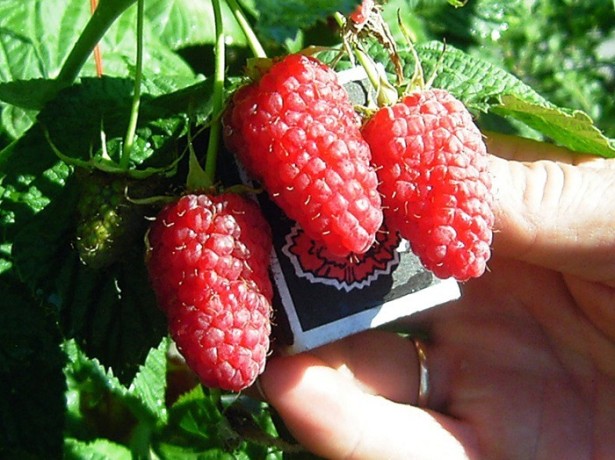
Grades of raspberry late in yield:
- Taganka;
- Thick;
- Brigantine;
- Mirage;
- Biryusinka;
- Peresvet;
- Metropolitan;
- Terenty;
- Companion.
Some summer residents grow raspberry varieties for higher yields. This variety gives a double crop collection. As a rule, this raspberry has no bright taste qualities. Only some "color varieties" are different in flavor and large size:
- Bryansk Divo
- Golden autumn
- Apricot
- Zhuravlik
- Indian summer
- Ruby Necklace
- Eurasia
- Mulatto
- Penguin
- Diamond
- Atlant
- Hercules
- Yellow Giant
Ivan, city of Saratov
"A neighbor discovered a black raspberry. In the spring I separated a couple of bushes. The variety is called "Mulatto". There's Cumberland. Juicy berry and yet it has an unusual aftertaste. There are many varieties on my land, I try what's tastier. While stopped on "Mulattos", "Sunny", "Yellow giant", "Moroseyka".
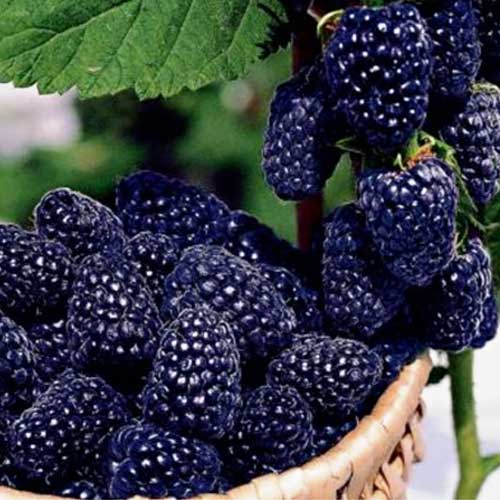
This article presents the rules of care for raspberries, types of diseases and pests and measures to combat them. Also considered are popular varieties of raspberries and reviews about them. Do not forget to conduct a timely sanation of the site and then you will not be afraid of any pests. Good harvest!


